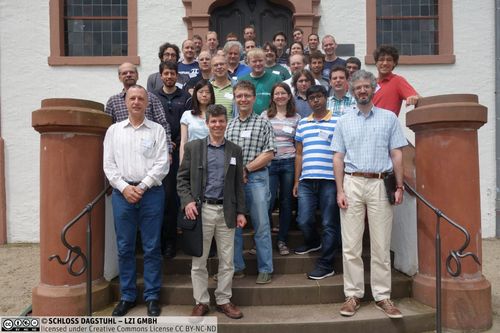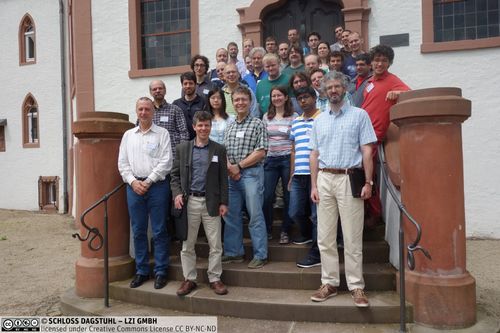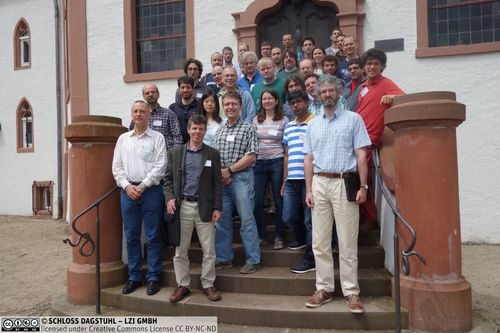Dagstuhl Seminar 16221
Algorithms for Optimization Problems in Planar Graphs
( May 29 – Jun 03, 2016 )
Permalink
Organizers
- Jeff Erickson (University of Illinois - Urbana-Champaign, US)
- Philip N. Klein (Brown University - Providence, US)
- Dániel Marx (Hungarian Academy of Sciences - Budapest, HU)
- Claire Mathieu (ENS - Paris, FR)
Contact
- Andreas Dolzmann (for scientific matters)
- Simone Schilke (for administrative matters)
Impacts
- Subexponential parameterized algorithms for graphs of polynomial growth - Marx, Daniel; Pilipczuk, Marcin - Cornell University : arXiv.org, 2016. - 11 pp..
- Towards Moral Autonomous Systems - Charisi, Vicky; Fisher, Michael; Lieck, Robert; Matthias, Andreas; Sombetzki, Janina; Yampolskiy, Roman; Winfield, Alan F. T.; Slavkovik, Marija; Dennis, Louise A. - Cornell University : arXiv.org, 2017. - 21 pp..
There is a long tradition of research in algorithms for optimization problems in graphs, including work on many classical problems, both polynomial-time solvable problems and NP-hard problems, e.g. shortest paths, maximum flow and minimum cut, matching, T-joins, disjoint paths, traveling salesman, Steiner tree, graph bisection, vehicle routing, facility location, k-center, and maximum cut. One theme of such research addresses the complexity of these problems when the input graph is required to be a planar graph or a graph embedded on a low-genus surface.
There are three reasons for this theme. First, optimization problems in planar graphs arise in diverse application areas. Second, researchers have discovered that, by exploiting the planarity of the input, much more effective algorithms can be developed - algorithms that are faster or more accurate than those that do not exploit graph structure. Third, the study of algorithms for surface-embedded graphs drives the development of interesting algorithmic techniques.
One source of applications for planar-graph algorithms is geographic problems. Road maps are nearly planar, for example, so distances in planar graphs can model, e.g., travel times in road maps. Network design in planar graphs can be used to model scenarios in which cables must be run under roads. Planar graphs can also be used to model metrics on the earth's surface that reflect physical features such as terrain; this aspect of planar graphs has been used in studying wildlife corridors. Another source of applications is image processing. Some algorithms for problems such as image segmentation and stereo involve finding minimum cuts in a grid in which each vertex represents a pixel. Sometimes an aggregation technique (superpixels) coalesces regions into vertices, turning the grid into an arbitrary planar graph. A third example application is VLSI.
Algorithmic exploitation of a planar embedding goes back at least to the introduction of maximum flow by Ford and Fulkerson in 1956. Current research can be divided in three parts. For polynomial-time-solvable problems, such as maximum flow, shortest paths, matching, and min-cost circulation, researchers seek planarity-exploiting algorithms whose running times beat those of general-graph algorithms, ideally algorithms whose running times are linear or nearly linear. For NP-hard problems, there are two strategies: fixed-parameter algorithms and approximation algorithms.
In all three research subareas, there has recently been significant progress. However, many researchers are expert in only one or two subareas. A key benefit of this Dagstuhl Seminar is to bring together researchers from the different subareas, to introduce them to techniques from subareas that might be unfamiliar, and to and foster collaboration across the subareas. The seminar will thus help to spur further advances in this active and growing area.
There is a long tradition of research in algorithms for optimization problems in graphs, including work on many classical problems, both polynomial-time solvable problems and NP-hard problems, e.g. shortest paths, maximum flow and minimum cut, matching, T-joins, disjoint paths, traveling salesman, Steiner tree, graph bisection, vehicle routing, facility location, k-center, and maximum cut. One theme of such research addresses the complexity of these problems when the input graph is required to be a planar graph or a graph embedded on a low-genus surface.
There are three reasons for this theme. First, optimization problems in planar graphs arise in diverse application areas. Second, researchers have discovered that, by exploiting the planarity of the input, much more effective algorithms can be developed -- algorithms that are faster or more accurate than those that do not exploit graph structure. Third, the study of algorithms for surface-embedded graphs drives the development of interesting algorithmic techniques. One source of applications for planar-graph algorithms is geographic problems. Road maps are nearly planar, for example, so distances in planar graphs can model, e.g., travel times in road maps. Network design in planar graphs can be used to model scenarios in which cables must be run under roads. Planar graphs can also be used to model metrics on the earth's surface that reflect physical features such as terrain; this aspect of planar graphs has been used in studying wildlife corridors. Another source of applications is image processing. Some algorithms for problems such as image segmentation and stereo involve finding minimum cuts in a grid in which each vertex represents a pixel. Sometimes an aggregation technique (superpixels) coalesces regions into vertices, turning the grid into an arbitrary planar graph. A third example application is VLSI. Algorithmic exploitation of a planar embedding goes back at least to the introduction of maximum flow by Ford and Fulkerson in 1956. Current research can be divided in three parts. For polynomial-time-solvable problems, such as maximum flow, shortest paths, matching, and min-cost circulation, researchers seek planarity-exploiting algorithms whose running times beat those of general-graph algorithms, ideally algorithms whose running times are linear or nearly linear. For NP-hard problems, there are two strategies: fixed-parameter algorithms and approximation algorithms. In all three research subareas, there has recently been significant progress. However, many researchers are expert in only one or two subareas. This Dagstuhl Seminar brought together researchers from the different subareas, to introduce them to techniques from subareas that might be unfamiliar, and to foster collaboration across the subareas. The seminar will thus help to spur further advances in this active and growing area. The scientific program of the seminar consisted of twenty-two talks. Four of these talks were longer (60--90 minute) tutorials overviewing the three main areas of the seminar:
- Polynomial-time algorithms:"Tutorial on embedded graph algorithms" (Jeff Erickson) and "Monge property, dense distance graphs and speeding-up max-flow computations in planar graphs" (Piotr Sankowski)
- Approximation schemes:"Some techniques for approximation schemes on planar graphs" (Philip Klein)
- Fixed-parameter tractability:"The square-root phenomenon in planar graphs" (Dániel Marx )
One of the main goals of the seminar was to encourage collaboration between the three communities, and these well-received tutorials helped by introducing the basics of each of these topics.
The rest of the talks were 25-minute presentations on recent research of the participants. The time between lunch and the afternoon coffee break was left open for individual discussions and collaborations in small groups. An open-problem session was organized on Monday morning. Notes on the presented problems can be found in this report.
 Jeff Erickson, Philip N. Klein, Dániel Marx, and Claire Mathieu
Jeff Erickson, Philip N. Klein, Dániel Marx, and Claire Mathieu
- Anna Adamaszek (University of Copenhagen, DK) [dblp]
- Mohammad Hossein Bateni (Google - New York, US) [dblp]
- Hans L. Bodlaender (Utrecht University, NL) [dblp]
- Sergio Cabello (University of Ljubljana, SI) [dblp]
- Vincent Cohen-Addad (CNRS / ENS - Paris, FR) [dblp]
- Zdenek Dvorák (Charles University - Prague, CZ) [dblp]
- Jeff Erickson (University of Illinois - Urbana-Champaign, US) [dblp]
- Thomas Erlebach (University of Leicester, GB) [dblp]
- Fedor V. Fomin (University of Bergen, NO) [dblp]
- Kyle Jordan Fox (Duke University - Durham, US) [dblp]
- Eli Fox-Epstein (Brown University - Providence, US) [dblp]
- Michelangelo Grigni (Emory University, US) [dblp]
- Bart Jansen (TU Eindhoven, NL) [dblp]
- Philip N. Klein (Brown University - Providence, US) [dblp]
- Lukasz Kowalik (University of Warsaw, PL) [dblp]
- Daniel Lokshtanov (University of Bergen, NO) [dblp]
- Dániel Marx (Hungarian Academy of Sciences - Budapest, HU) [dblp]
- Claire Mathieu (ENS - Paris, FR) [dblp]
- Bojan Mohar (Simon Fraser University - Burnaby, CA) [dblp]
- Shay Mozes (Interdisciplinary Center Herzliya, IL) [dblp]
- Marcin Pilipczuk (University of Warsaw, PL) [dblp]
- Michal Pilipczuk (University of Warsaw, PL) [dblp]
- Peter Rossmanith (RWTH Aachen, DE) [dblp]
- Piotr Sankowski (University of Warsaw, PL) [dblp]
- Ignasi Sau Valls (CNRS - Montpellier, FR) [dblp]
- Saket Saurabh (The Institute of Mathematical Sciences, IN) [dblp]
- Aaron Schild (Berkeley, US) [dblp]
- Andreas Schmid (MPI für Informatik - Saarbrücken, DE) [dblp]
- Anastasios Sidiropoulos (Ohio State University - Columbus, US) [dblp]
- Dimitrios M. Thilikos (University of Athens, GR) [dblp]
- Tom van der Zanden (Utrecht University, NL) [dblp]
- Erik Jan van Leeuwen (MPI für Informatik - Saarbrücken, DE) [dblp]
- Oren Weimann (University of Haifa, IL) [dblp]
- Andreas Wiese (MPI für Informatik - Saarbrücken, DE) [dblp]
- Christian Wulff-Nilsen (University of Copenhagen, DK) [dblp]
- Hang Zhou (MPI für Informatik - Saarbrücken, DE) [dblp]
- Anna Zych-Pawlewicz (University of Warsaw, PL) [dblp]
Related Seminars
- Dagstuhl Seminar 13421: Algorithms for Optimization Problems in Planar Graphs (2013-10-13 - 2013-10-18) (Details)
Classification
- data structures / algorithms / complexity
- optimization / scheduling
Keywords
- planar graphs
- algorithms
- combinatorial optimization
- approximation
- shortest paths
- Steiner tree
- multiway cut
- flows




 Creative Commons BY 3.0 Unported license
Creative Commons BY 3.0 Unported license
